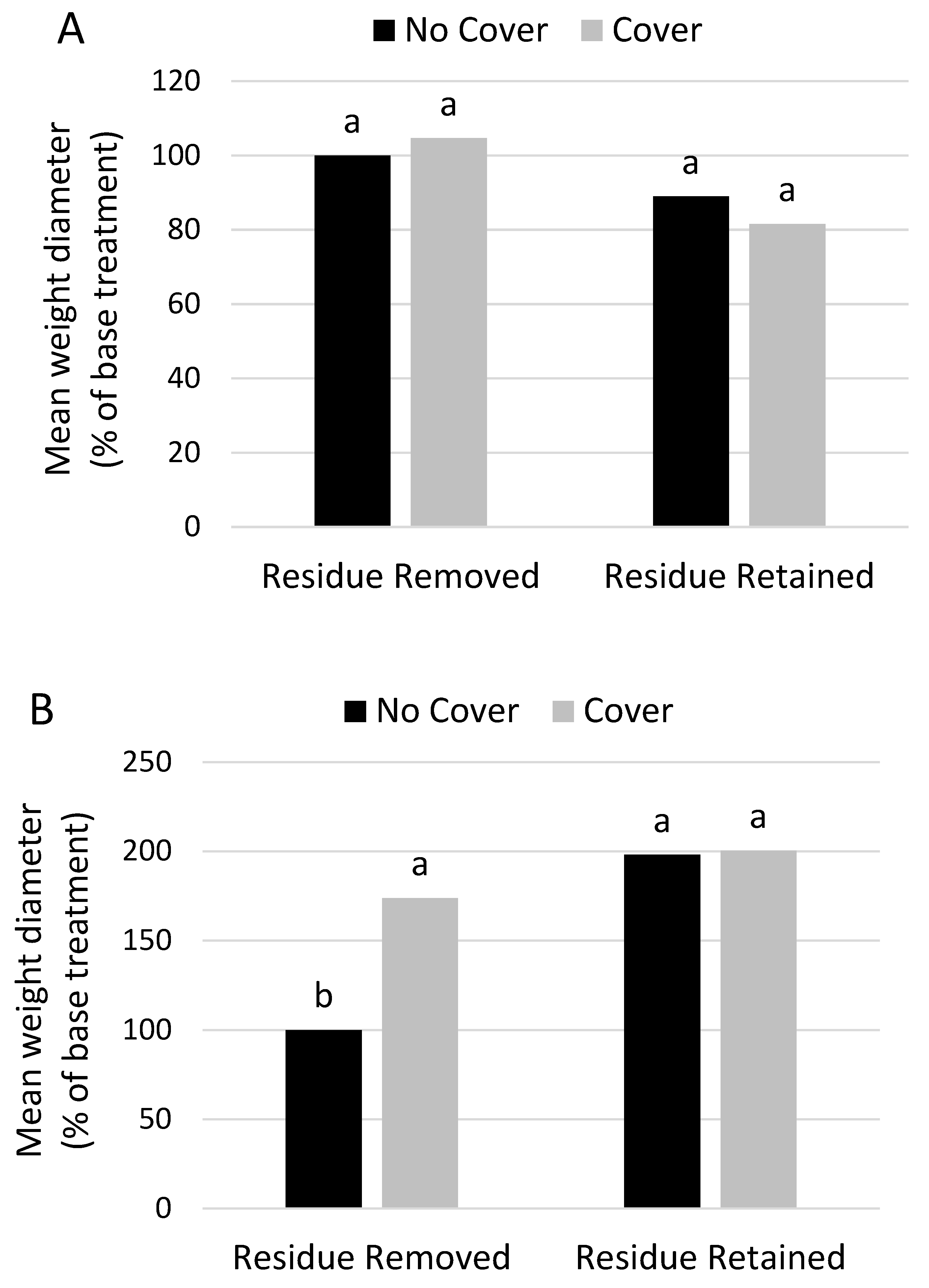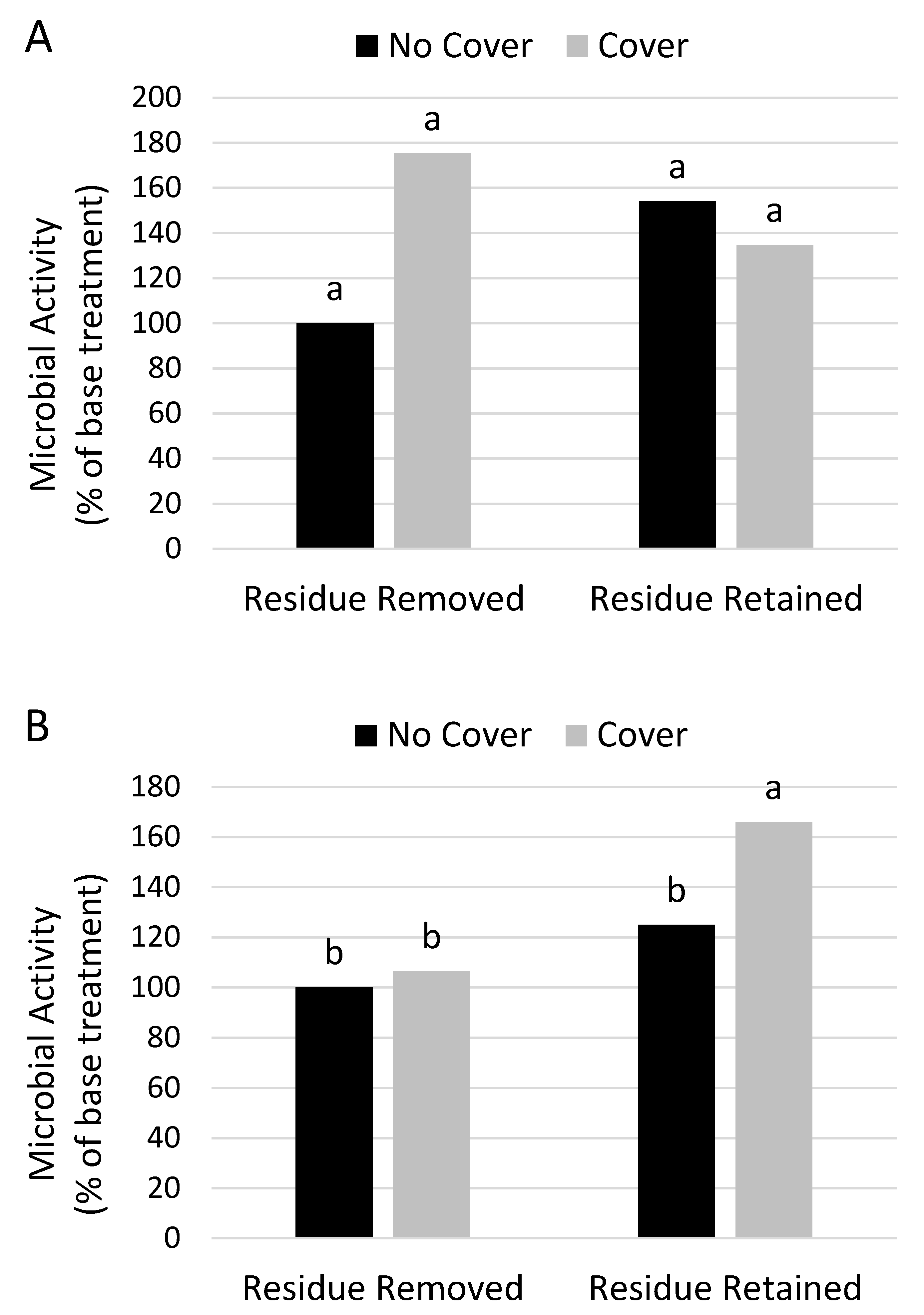Stacking Agricultural Management Tactics to Promote Improvements in Soil Structure and Microbial Activities
Abstract
:1. Introduction
2. Materials and Methods
2.1. Study Site
2.2. Experimental Plots, Agricultural Management and Soil Sampling
2.2.1. Field Study 1
2.2.2. Field Study 2
2.3. Soil Physical and Biological Analyses
2.4. Statistics
3. Results
3.1. Field Study 1
3.2. Field Study 2
4. Discussion
4.1. Field Study 1
4.2. Field Study 2
4.3. Summary of Both Case Studies
5. Conclusions
Author Contributions
Funding
Acknowledgments
Conflicts of Interest
References
- Pimentel, D.; Harvey, C.; Resosudarmo, P.; Sinclair, K.; Kurz, D.; McNair, M.; Crist, S.; Shpritz, L.; Fitton, L.; Saffouri, R.; et al. Environmental and economic costs of soil erosion and conservation Benefits. Science 1995, 267, 1117–1123. [Google Scholar] [CrossRef] [PubMed]
- Bünemann, E.K.; Bongiorno, G.; Bai, Z.; Creamer, R.E.; De Deyn, G.; de Goede, R.; Fleskens, L.; Geissen, V.; Kuyper, T.W.; Mäder, P. Soil quality—A critical review. Soil Biol. Biochem. 2018, 120, 105–125. [Google Scholar] [CrossRef]
- Wolińska, A.; Kuźniar, A.; Zielenkiewicz, U.; Banach, A.; Błaszczyk, M. Indicators of arable soils fatigue–Bacterial families and genera: A metagenomic approach. Ecol. Indic. 2018, 93, 490–500. [Google Scholar] [CrossRef]
- Lehman, R.M.; Cambardella, C.A.; Stott, D.E.; Acosta-Martinez, V.; Manter, D.K.; Buyer, J.S.; Maul, J.E.; Smith, J.L.; Collins, H.P.; Halvorson, J.J. Understanding and enhancing soil biological health: The solution for reversing soil degradation. Sustainability 2015, 7, 988–1027. [Google Scholar] [CrossRef]
- Bender, S.F.; Heijden, M.G. Soil biota enhance agricultural sustainability by improving crop yield, nutrient uptake and reducing nitrogen leaching losses. J. Appl. Ecol. 2015, 52, 228–239. [Google Scholar] [CrossRef]
- Wagg, C.; Bender, S.F.; Widmer, F.; van der Heijden, M.G.A. Soil biodiversity and soil community composition determine ecosystem multifunctionality. Proc. Natl. Acad. Sci. USA 2014, 111, 5266–5270. [Google Scholar] [CrossRef] [PubMed] [Green Version]
- Köhl, L.; Oehl, F.; van der Heijden, M.G.A. Agricultural practices indirectly influence plant productivity and ecosystem services through effects on soil biota. Ecol. Appl. 2014, 24, 1842–1853. [Google Scholar] [CrossRef]
- Wilson, G.W.; Rice, C.W.; Rillig, M.C.; Springer, A.; Hartnett, D.C. Soil aggregation and carbon sequestration are tightly correlated with the abundance of arbuscular mycorrhizal fungi: Results from long-term field experiments. Ecol. Lett. 2009, 12, 452–461. [Google Scholar] [CrossRef]
- Pretty, J. Intensification for redesigned and sustainable agricultural systems. Science 2018, 362. [Google Scholar] [CrossRef]
- Cassman, K.G. Ecological intensification of cereal production systems: Yield potential, soil quality, and precision agriculture. Proc. Natl. Acad. Sci. USA 1999, 96, 5952–5959. [Google Scholar] [CrossRef] [Green Version]
- Davis, A.S.; Hill, J.D.; Chase, C.A.; Johanns, A.M.; Liebman, M. Increasing cropping system diversity balances productivity, profitability, and environmental health. PLoS ONE 2012, 7, e47149. [Google Scholar] [CrossRef] [PubMed]
- Lehman, R.M.; Osborne, S.L.; Duke, S.E. Diversified no-till crop rotation reduces nitrous oxide emissions, increases soybean yields, and promotes soil carbon accrual. Soil Sci. Soc. Am. J. 2017, 81, 76–83. [Google Scholar] [CrossRef]
- Yamoah, C.F.; Francis, C.A.; Varvel, G.E.; Waltman, W.J. Weather and management impact on crop yield variability in rotations. J. Prod. Agric. 1998, 11, 219–225. [Google Scholar] [CrossRef]
- Gaudin, A.C.M.; Tolhurst, T.N.; Ker, A.P.; Janovicek, K.; Tortora, C.; Martin, R.C.; Deen, W. Increasing crop diversity mitigates weather variations and improves yield stability. PLoS ONE 2015, 10, e0113261. [Google Scholar] [CrossRef] [PubMed]
- NRCS. Recommended Soil Health Indicators and Associated Laboratory Procedures; U.S. Dept. of Agriculture Natural Resources Conservation Service: Washington, DC, USA, 2019.
- Pittelkow, C.M.; Liang, X.; Linquist, B.A.; Van Groenigen, K.J.; Lee, J.; Lundy, M.E.; van Gestel, N.; Six, J.; Venterea, R.T.; van Kessel, C. Productivity limits and potentials of the principles of conservation agriculture. Nature 2015, 517, 365–368. [Google Scholar] [CrossRef] [PubMed]
- Kinoshita, R.; Schindelbeck, R.R.; van Es, H.M. Quantitative soil profile-scale assessment of the sustainability of long-term maize residue and tillage management. Soil Tillage Res. 2017, 174, 34–44. [Google Scholar] [CrossRef]
- Nunes, M.R.; van Es, H.M.; Schindelbeck, R.; Ristow, A.J.; Ryan, M. No-till and cropping system diversification improve soil health and crop yield. Geoderma 2018, 328, 30–43. [Google Scholar] [CrossRef]
- Bryce, S.A.; Omernik, J.M.; Pater, D.E.; Ulmer, M.; Schaar, J.; Freeouf, J.; Johnson, R.; Kuck, P.; Azevedo, S.H. Ecoregions of North Dakota and South Dakota (Map Scale 1:1,500,000); U.S. Geological Survey: Reston, VA, USA, 1996.
- NRCS. Land Resource Regions and Major Land Resource Areas of the United States, the Caribbean, and the Pacific Basin; U.S. Department of Agriculture Handbook 296; U.S. Department of Agriculture: Washington, DC, USA, 2006.
- Pikul, J.L.; Osborne, S.; Ellsbury, M.; Riedell, W. Particulate organic matter and water-stable aggregation of soil under contrasting management. Soil Sci. Soc. Am. J. 2007, 71, 766–776. [Google Scholar] [CrossRef]
- Hammerbeck, A.L.; Stetson, S.J.; Osborne, S.L.; Schumacher, T.E.; Pikul, J.L. Corn residue removal impact on soil aggregates in a no-till corn/soybean rotation. Soil Sci. Soc. Am. J. 2012, 76, 1390–1398. [Google Scholar] [CrossRef]
- Stetson, S.J.; Osborne, S.L.; Schumacher, T.E.; Eynard, A.; Chilom, G.; Rice, J.; Nichols, K.A.; Pikul, J.L. Corn residue removal impact on topsoil organic carbon in a corn–soybean rotation. Soil Sci. Soc. Am. J. 2012, 76, 1399–1406. [Google Scholar] [CrossRef]
- Wegner, B.R.; Osborne, S.L.; Lehman, R.M.; Kumar, S. Seven-year impact of cover crops on soil health when residue is removed. BioEnergy Res. 2018, 11, 239–248. [Google Scholar] [CrossRef]
- Blanco-Canqui, H.; Mikha, M.M.; Presley, D.R.; Claassen, M.M. Addition of cover crops enhances no-till potential for improving soil physical properties. Soil Sci. Soc. Am. J. 2011, 75, 1471–1482. [Google Scholar] [CrossRef]
- Lehman, R.M.; Ducey, T.F.; Jin, V.L.; Acosta-Martinez, V.; Ahlschwede, C.M.; Jeske, E.S.; Drijber, R.A.; Cantrell, K.B.; Frederick, J.R.; Fink, D.M. Soil microbial community response to corn stover harvesting under rain-fed, no-till conditions at multiple US locations. BioEnergy Res. 2014, 7, 540–550. [Google Scholar] [CrossRef]
- Lehman, R.M.; Osborne, S.L. Soil greenhouse gas emissions and carbon dynamics of a no-till, corn-based cellulosic ethanol production system. BioEnergy Res. 2016, 9, 1101–1108. [Google Scholar] [CrossRef]
- Chepil, W.S. Compact rotary sieve and the importance of dry sieving in physical soil analysis. Soil Sci. Soc. Proc. 1962, 26, 4–6. [Google Scholar] [CrossRef]
- Youker, R.; McGuinness, J. A short method of obtaining mean weight-diameter values of aggregate analyses of soils. Soil Sci. 1957, 83, 291–294. [Google Scholar] [CrossRef]
- Merrill, S.D.; Black, A.L.; Fryrear, D.W.; Saleh, A.; Zobeck, T.M.; Halvorson, A.D.; Tanaka, D.L. Soil wind erosion hazard of spring wheat–fallow as affected by long-term climate and tillage. Soil Sci. Soc. Am. J. 1999, 63, 1768–1777. [Google Scholar] [CrossRef]
- Franzluebbers, A.J. Potential C and N mineralization and microbial biomass from intact and increasingly disturbed soils of varying texture. Soil Biol. Biochem. 1999, 31, 1083–1090. [Google Scholar] [CrossRef] [Green Version]
- Adam, G.; Duncan, H. Development of a sensitive and rapid method for the measurement of total microbial activity using fluorescein diacetate (FDA) in a range of soils. Soil Biol. Biochem. 2001, 33, 943–951. [Google Scholar] [CrossRef] [Green Version]
- Schumacher, T.E.; Eynard, A.; Chintala, R. Rapid cost-effective analysis of microbial activity in soils using modified fluorescein diacetate method. Environ. Sci. Pollut. Res. 2015, 22, 4759–4762. [Google Scholar] [CrossRef]
- Moebius-Clune, B.N.; Van Es, H.M.; Idowu, O.J.; Schindelbeck, R.R.; Moebius-Clune, D.J.; Wolfe, D.W.; Abawi, G.S.; Thies, J.E.; Gugino, B.K.; Lucey, R. Long-term effects of harvesting maize stover and tillage on soil quality. Soil Sci. Soc. Am. J. 2008, 72, 960–969. [Google Scholar] [CrossRef]
- McDaniel, M.D.; Tiemann, L.K.; Grandy, A.S. Does agricultural crop diversity enhance soil microbial biomass and organic matter dynamics? A meta-analysis. Ecol. Appl. 2014, 24, 560–570. [Google Scholar] [CrossRef] [PubMed] [Green Version]
- Bullock, D.G. Crop rotation. Crit. Rev. Plant Sci. 1992, 11, 309–326. [Google Scholar] [CrossRef]
- Benitez, M.-S.; Osborne, S.L.; Lehman, R.M. Previous crop and rotation history effects on maize seedling health and associated rhizosphere microbiome. Sci. Rep. 2017, 7, 15709. [Google Scholar] [CrossRef] [PubMed]
- Meisner, M.H.; Rosenheim, J.A. Ecoinformatics reveals effects of crop rotational histories on cotton yield. PLoS ONE 2014, 9, e85710. [Google Scholar] [CrossRef]
- Anderson, R.L. Are some crops synergistic to following crops? Agron. J. 2005, 97, 7–10. [Google Scholar]
- Kirkegaard, J.A.; Ryan, M.H. Magnitude and mechanisms of persistent crop sequence effects on wheat. Field Crop Res. 2014, 164, 154–165. [Google Scholar] [CrossRef]
- Franzluebbers, A.J. Should soil testing services measure soil biological activity? Agric. Environ. Lett. 2016, 1. [Google Scholar] [CrossRef]
- Franzluebbers, A.J.; Stuedemann, J.A. Early response of soil organic fractions to tillage and integrated crop–livestock production. Soil Sci. Soc. Am. J. 2008, 72, 613–625. [Google Scholar] [CrossRef]
- Lupwayi, N.Z.; Lafond, G.P.; May, W.E.; Holzapfel, C.B.; Lemke, R.L. Intensification of field pea production: Impact on soil microbiology. Agron. J. 2012, 104, 1189–1196. [Google Scholar] [CrossRef]
- Schnurer, J.; Rosswall, T. Fluorescein diacetate hydrolysis as a measure of total microbial activity in soil and litter. Appl. Environ. Microbiol. 1982, 43, 1256–1261. [Google Scholar]
- Janvier, C.; Villeneuve, F.; Alabouvette, C.; Edel-Hermann, V.; Mateille, T.; Steinberg, C. Soil health through soil disease suppression: Which strategy from descriptors to indicators? Soil Biol. Biochem. 2007, 39, 1–23. [Google Scholar] [CrossRef]
- Mendes, I.C.; Bandick, A.K.; Dick, R.P.; Bottomley, P.J. Microbial biomass and activities in soil aggregates affected by winter cover crops. Soil Sci. Soc. Am. J. 1999, 63, 873–881. [Google Scholar] [CrossRef]
- Karlen, D.L.; Wollenhaupt, N.C.; Erbach, D.C.; Berry, E.C.; Swan, J.B.; Eash, N.S.; Jordahl, J.L. Crop residue effects on soil quality following 10-years of no-till corn. Soil Tillage Res. 1994, 31, 149–167. [Google Scholar] [CrossRef]
- Watt, M.; Kirkegaard, J.; Passioura, J. Rhizosphere biology and crop productivity—A review. Soil Res. 2006, 44, 299–317. [Google Scholar] [CrossRef]






| Factor | Aggregate Mean Weight Diameter | Erodible Fraction | FDA a Hydrolysis | |||
|---|---|---|---|---|---|---|
| Corn | Soybean | Corn | Soybean | Corn | Soybean | |
| Cover Crop | 0.784 | 0.084 | 0.117 | 0.032 | 0.153 | 0.028 |
| Residue | 0.167 | 0.034 | 0.715 | 0.006 | 0.821 | 0.024 |
| Cover Crop×Residue | 0.282 | 0.093 | 0.481 | 0.038 | 0.168 | 0.069 |
© 2019 by the authors. Licensee MDPI, Basel, Switzerland. This article is an open access article distributed under the terms and conditions of the Creative Commons Attribution (CC BY) license (http://creativecommons.org/licenses/by/4.0/).
Share and Cite
Lehman, R.M.; Osborne, S.L.; McGraw, K. Stacking Agricultural Management Tactics to Promote Improvements in Soil Structure and Microbial Activities. Agronomy 2019, 9, 539. https://doi.org/10.3390/agronomy9090539
Lehman RM, Osborne SL, McGraw K. Stacking Agricultural Management Tactics to Promote Improvements in Soil Structure and Microbial Activities. Agronomy. 2019; 9(9):539. https://doi.org/10.3390/agronomy9090539
Chicago/Turabian StyleLehman, R. Michael, Shannon L. Osborne, and Kimberly McGraw. 2019. "Stacking Agricultural Management Tactics to Promote Improvements in Soil Structure and Microbial Activities" Agronomy 9, no. 9: 539. https://doi.org/10.3390/agronomy9090539




